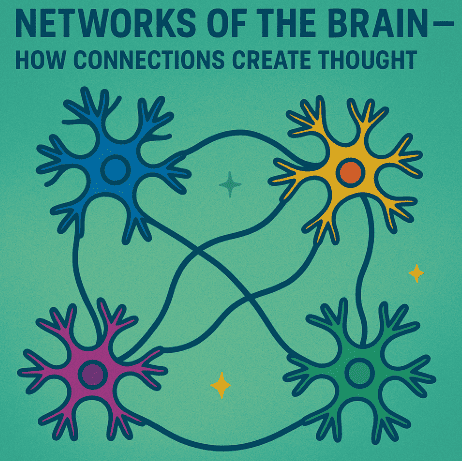
Recap of Lesson 3
Last time, we learned:
-
Neurons send electrical sparks called action potentials.
-
Sparks travel down axons, sped up by myelin insulation.
-
At synapses, neurons pass messages with neurotransmitters like dopamine, serotonin, and glutamate.
-
Excitatory signals (gas) and inhibitory signals (brakes) keep the brain balanced.
-
Thought is not in one neuron but in patterns of firing across many neurons.
Now, the big question: How do these trillions of sparks, across billions of neurons, come together to create thoughts, memories, and intelligence?
Section 1: The Brain as a Giant Social Network
Imagine Facebook or Instagram 📱. Each person is like a neuron, and the “friends” or “followers” are the connections.
-
One person alone cannot make a network.
-
Millions of people sharing, liking, and posting creates patterns — trends, memes, news cycles.
The brain works the same way. One neuron alone can only send a weak signal. But when billions of them connect, they form networks that can recognize a face, solve a math problem, or create a symphony.
So, the mind is not in the neurons themselves, but in the connections between them.
Section 2: Synapses – The Wiring of the Brain
Every neuron can connect to up to 10,000 other neurons. Multiply this by 86 billion neurons, and you get an unimaginable number of trillions of synapses.
This dense web of synapses is called the connectome.
-
If you stretched out all the axons in your brain, they would be about 800,000 kilometers long — enough to circle Earth 20 times 🌍!
-
These connections are not fixed — they change with learning and experience. This property is called neuroplasticity.
The connectome is like a road map of the mind. Just like roads connect cities, synapses connect neurons. And just like traffic patterns change, brain connections change too.
Section 3: Neural Circuits – Specialized Teams
Neurons don’t just connect randomly. They form circuits — groups of neurons working together for specific jobs.
Examples:
-
The visual circuit (in the occipital lobe) processes what your eyes see 👀.
-
The motor circuit (in the frontal lobe and spinal cord) controls movement 🏃.
-
The hippocampal circuit helps form and retrieve memories 🧳.
Think of these like specialized departments in a company. One department handles finance, another handles design, another marketing. But they all work together to make the company successful.
Section 4: Hebb’s Rule – “Neurons That Fire Together, Wire Together”
In 1949, psychologist Donald Hebb proposed a famous idea:
When two neurons fire at the same time, their connection strengthens.
This is called Hebbian learning.
Example:
-
You see a dog 🐶.
-
You hear the word “dog.”
-
The visual neurons (dog picture) and auditory neurons (dog sound) fire together.
-
Over time, they form a strong link — now whenever you see a dog, you can recall the word “dog.”
This simple rule explains how learning happens in the brain. Repetition strengthens connections, while unused connections fade.
Section 5: Patterns = Thoughts
Every thought you have is a pattern of neurons firing in networks.
-
Saying “apple” 🍎 lights up a pattern in your language and visual circuits.
-
Hearing your favorite song 🎶 lights up auditory, memory, and emotion circuits.
-
Solving a math problem ➕ lights up logic and working memory circuits.
These patterns can be seen with brain imaging (like fMRI). Scientists can sometimes even guess what you’re looking at by reading your brain patterns!
Section 6: The Power of Small-World Networks
The brain’s networks are arranged in a small-world fashion. That means:
-
Each neuron has many local connections (like your close friends).
-
But there are also a few long-distance connections (like international friends).
This structure makes communication fast and efficient. Just like social media can spread a meme worldwide in hours, brain networks can spread signals quickly across regions.
Section 7: When Networks Go Wrong
Sometimes, brain networks misfire:
-
Epilepsy → networks fire too much, causing seizures.
-
Schizophrenia → networks may misconnect, causing hallucinations.
-
Autism → networks may be over- or under-connected in different regions.
-
Alzheimer’s → memory networks break down as neurons die.
Healthy thought depends on healthy networks.
Section 8: Networks Beyond Biology – Inspiration for AI
Artificial Intelligence (AI) uses artificial neural networks inspired by the brain.
-
Each “node” in AI is like a neuron.
-
Connections between nodes strengthen with learning, just like Hebbian learning.
-
These networks power image recognition, speech recognition, and even ChatGPT 😉.
So, by studying brain networks, we also learn how to build smarter machines.
Section 9: The Big Picture
We now understand:
-
Neurons form networks, not isolated signals.
-
These networks create patterns of activity, which are the basis of thoughts, memories, and feelings.
-
Networks change with learning (Hebbian learning).
-
The brain’s connectome is like the internet of the body — vast, dynamic, and ever-changing.
Next lesson, we’ll look at the brain’s defense system: Lesson 5 – “The Brain’s Bodyguards: Skull, Membranes, and Protective Fluids.”